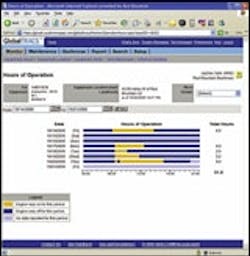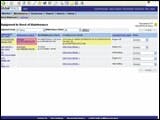How to Choose Asset-Tracking Systems
One of the most challenging facets of managing a fleet is keeping up with the machines and knowing what they are doing — or not doing.
One way to pinpoint equipment location and tell if it's running or not is by investing in an asset-tracking system. At its most basic level, asset tracking identifies where the machine is and how many hours it runs each day. Knowing the location has numerous benefits, allowing fleet managers to find and move a machine from one site, where it's not being used, to another site where it's needed. Hours run, of course, contributes to equipment utilization and productivity.
On a more advanced level, tracking systems can send out alerts when something is wrong with a unit or maintenance is overdue. The system monitors engine starts and stops, maintenance data and usage hours, all of which helps equipment professionals establish better preventive maintenance schedules. When used with a "geo-fence," these systems also alert managers when a machine arrives at a particular job and when it leaves that job.
"A geo-fence is an imaginary fence around a piece of equipment," says Jay Dee Sale, director of operations for Red Mountain Machinery. Red Mountain is a heavy equipment rental firm that serves southern California, Arizona and southern Nevada. It has equipment all over the territory, so two years ago the company installed a system called GlobalTRACS from Qualcomm.
Asset tracking and asset management are not synonymous, says Will McFadyen, president of McFadyen & Associates, a full-scale technical consultancy and custom programming group focused on contractors, rental houses, OEMs and equipment dealers.
"There's a big difference between the two," he says. "Asset-tracking software lets you know where the equipment is. It also provides basic functions, such as how long the machine has been running, and basic preventive maintenance data. It might not necessarily include such things as detailed maintenance calculations, purchase orders, work orders, and utilization analysis. Those types of things are reflected in asset-management software."
Of course, asset-tracking and asset-management systems can be, and often are, integrated. In a successful marriage of the two systems, for example, the hours a unit runs at a particular jobsite can be accurately tabulated and transferred into the asset-management system to determine the exact amount charged back to that particular project. The down side of that transaction, however, is that managers can't distinguish between actual hours run and idling hours, such as time spent warming the machine up on a cold morning, without the incorporation of sensors.
Yet when all the benefits are considered, McFadyen says, asset tracking is "absolutely advantageous" to contractors, rental houses, OEMs and, "anybody involved within the equipment triangle."
One person who is part of that triangle is Joe Schuster, fleet manager at Emery Sapp & Sons. The company, with a fleet of about 500 machines, half of which are heavy equipment, provides road and bridge building, concrete paving, and residential and commercial site development in central and western Missouri, eastern Kansas and northwestern Arkansas. "At any given time, we probably have 50-plus different jobs underway in three different states," Schuster says.
Although Schuster's system, also GlobalTRACS, is fairly new — installed in July 2005 — he's already seeing benefits, he says. Previously he relied on field crew supervisors to turn in progress reports. Many times that didn't happen, and when it did, the information was not accurate or timely. Asset tracking has definitely solved that problem, he says. As a result, the company now has better timing on oil changes, for example.
The system also has cut down on time spent traveling to a jobsite to service a piece of equipment, only to return and discover the next day that there were two more units at the same jobsite that also needed servicing, Schuster says.
Another benefit is that the company can now group and manage preventive maintenance schedules much more efficiently. "Prior to the winter season, it's critical that we check the anti-freeze levels in each piece of equipment," Schuster says. "We also have to determine if the coolant is actually protecting the equipment to the degree it needs to. With our system, it's easy to locate where each unit is."
Schuster's rental expenses also have gone down. "The jobs vary so much year to year that it's hard to quantify how much," he says. "I know when we get a request to rent a piece of equipment, we look in the system and many times move a unit that is being under-utilized."
Although there are a number of fleet-tracking system providers, McFadyen says, the "Coke, Pepsi, and 7-Up kind of crowd" include Qualcomm, Trimble, and Micrologic in addition to Caterpillar, Komatsu, and others.
No matter what brand of asset-tracking system is installed, McFadyen says, it shouldn't necessarily change how you do business. "It should be used to enhance your knowledge about the business that you're doing," he says. "Fleet tracking can give you a wealth of data, and one of the things you want to do is ask your provider to turn that raw data into useful information."
Once the information makes sense, says McFadyen, it can most certainly affect bottom-line decisions. "Information from these systems helps you determine things like fleet optimization in terms of knowing which pieces of equipment are your dogs — that is, the units that are under-performing," he says. "They will help you better plan your PMs since scheduled maintenance will come into vision a lot more clearly than it would if you weren't using a system like this.
"The nice part about it is that once you have the equipment location and hours, you can build a maintenance system that will be able to incorporate cost," he says. "You will know what it cost per hour to own and operate that equipment. This is a huge issue in construction."
Before such technology came along, supervisors, for instance, turned in time sheets that showed how long the equipment ran for a given period of time or when it was due for service. "This still goes on today, but a lot of time it's a guessing game," McFadyen says. "There tends to be a lot less accurate data when it's recorded by humans."
The supervisor in the field, he says, might guess that the machine ran for seven hours when, in reality, it ran for 11 hours. This causes the actual hours used to be either over- or under-estimated.
"Obviously, that has a big affect on the bottom line," he says. "It raises such questions as, 'Am I doing my PMs too soon because of that, or too late?' If PMs are done too quickly, you could be spending too much money. If a PM is done too late, it affects the condition of the equipment and could be eating away the health of major components. That causes the machine to fail more quickly. When you're talking about a machine that costs $500, 000, that's a pretty substantial chunk of change."
Sale describes how his system works in terms of hours and maintenance. "We schedule PMs at 250 hours," he says. "We know every day what the hours are on the machine. We are able to be more exact, and by knowing what the hours really are, we know exactly when to do the PM."
In addition to accuracy, the system reports are valuable tools for fleet managers. There are the monitoring hours and location reports, already mentioned, and Schuster also receives an equipment-maintenance summary.
"The summary tells us when an oil change is due on a machine," he says. "At 50 hours prior to service being due, the system will flag that machine as yellow and drop it into a group of machines to be serviced. If the unit goes over the service interval of 250 hours, the system highlights the equipment in red."
Another report shows what pieces of equipment are on a certain job and what jobs a particular machine has been on and when, he says. "It will tell you the history of that unit for the last three months."
Schuster has just reached the point where he can now use the system to monitor the health of a unit. "We set up alerts to tell us if oil pressure drops below a certain level or if an engine coolant temperature climbs above a certain level," he says. "It lets us know when a transmission temperature reaches a critical level. When that happens, the system sends out an alert."
The alerts go out in three ways: via e-mail, to a pager, and to three different cell phones until someone answers. Schuster had problems installing the system on older equipment. Although the boxes on the machines are "fairly durable," he says, "if you happen to have an electrical problem on the older units, it sends you a false alert. You have to make certain your electrical system is up to snuff or you'll get some bad data." This particular problem showed up in about 5 percent of his fleet, he says.
As for the system used for tracking and reporting at Red Mountain, it's not surprising that the reports that have made the most difference, according to Sale, are the ones showing the hours a machine runs. That up-to-date data, he says, is something the company never had before.
"We didn't know if the machines were being run 24 hours a day or an hour every three days," he says. "It was very hard to know when to schedule preventive maintenance. Now we can schedule our service people to do the PM at the correct time."
The value of asset-tracking reports many times depends on the industry, according to McFadyen. For example, a contractor might be extremely interested in utilization because he may be thinking of streamlining the fleet. A rental house, on the other hand, might focus on preventive maintenance features to ensure everything is done on time.
Since the construction industry has now caught the attention of a number of asset-tracking system providers, fleet professionals should try out different programs before making a final decision.
Most providers usually give you a three-month trial period, says Schuster. "If you don't decide to go with that particular system, you send the equipment back. You may have to pay a small fee for the air time you use." Sale also tried out several systems before making his decision, he says.
In addition to comparing the different systems, there are other guidelines that equipment managers should heed.
- Work with a provider that provides the means to integrate its fleet-tracking solution with either a fleet-management or maintenance application.
- Consider the hardware itself, the physical toughness and ability to stand up to the rigors of the construction-equipment environment.
- Determine the need for a satellite-based system or a cellular system. Satellite is good for companies that have equipment going outside the area. Cellular systems, as the name implies, work best where you have cellular coverage. Satellite systems usually cost a bit more than cellular.
- Know the reliability of the messaging network. How long does it take for the message to travel from the equipment, to the message center, then to you?
- Find out who sees and owns the data. What are their intentions on how the data will be used?
- Make sure the captured data is secure. Is it stored on the user's site or at the provider's site? What precaution is the provider taking to ensure data doesn't go into somebody else's hands?
- Make certain the provider really understands the industry.
- Try to work with well-established providers. Invest in a system from a company that will be around a few years from now.



